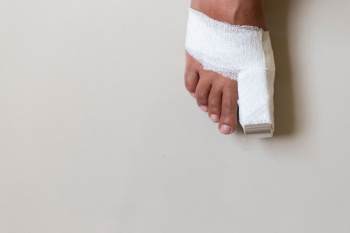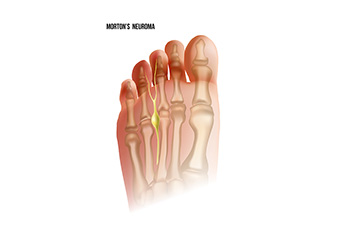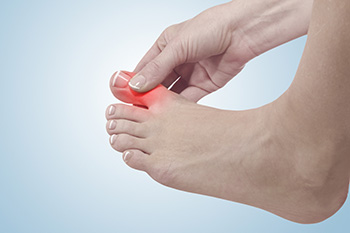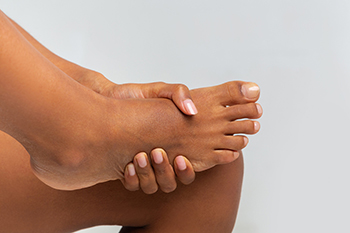Items filtered by date: January 2025
Broken Toe Care

A fractured or broken toe typically results from trauma, such as stubbing the toe, dropping a heavy object on it, or sports injuries. Repetitive stress from activities like running can also cause small fractures over time. Common symptoms include swelling, bruising, redness, and difficulty walking. The toe may appear misaligned, and pain intensifies when trying to move or put weight on it. Treatment depends on the severity. For minor fractures, rest and elevation can help reduce swelling. Taping the injured toe to a neighboring one, known as buddy taping, provides support. However, severe fractures, such as those involving dislocation or improper alignment, may require immobilization, specialized footwear, or even surgery to ensure proper healing. If you suspect a fractured toe, it is suggested that you seek prompt evaluation by a podiatrist to prevent complications and ensure effective recovery.
Broken toes may cause a lot of pain and should be treated as soon as possible. If you have any concerns about your feet, contact one of our podiatrists from Palmetto Podiatry Group of Anderson. Our doctors will treat your foot and ankle needs.
What Is a Broken Toe?
A broken toe occurs when one or more of the toe bones of the foot are broken after an injury. Injuries such as stubbing your toe or dropping a heavy object on it may cause a toe fracture.
Symptoms of a Broken Toe
- Swelling
- Pain (with/without wearing shoes)
- Stiffness
- Nail Injury
Although the injured toe should be monitored daily, it is especially important to have a podiatrist look at your toe if you have severe symptoms. Some of these symptoms include worsening or new pain that is not relieved with medication, sores, redness, or open wounds near the toe.
If you have any questions, please feel free to contact our office located in Anderson, SC . We offer the newest diagnostic and treatment technologies for all your foot care needs.
What Is Morton’s Neuroma?

Morton's neuroma is a condition that affects the nerves in the foot, typically between the third and fourth toes. It occurs when the tissue around a nerve thickens, leading to pain, numbness, or a sensation of a lump in the affected area. Symptoms may worsen when wearing tight shoes or high heels, as the pressure on the foot increases. Common causes include repetitive stress or irritation to the foot, from high-impact activities, poorly fitted footwear, or foot abnormalities like flat feet or high arches. To diagnose Morton's neuroma, a podiatrist will typically perform a physical examination, checking for tenderness or swelling between the toes. Imaging tests, such as an ultrasound or MRI scan, may also be used to confirm the diagnosis and rule out other conditions. If you have pain in this area of your foot, it is suggested that you consult a podiatrist who can provide an accurate diagnosis and treatment.
Morton’s neuroma is a very uncomfortable condition to live with. If you think you have Morton’s neuroma, contact one of our podiatrists of Palmetto Podiatry Group of Anderson. Our doctors will attend to all of your foot care needs and answer any of your related questions.
Morton’s Neuroma
Morton's neuroma is a painful foot condition that commonly affects the areas between the second and third or third and fourth toe, although other areas of the foot are also susceptible. Morton’s neuroma is caused by an inflamed nerve in the foot that is being squeezed and aggravated by surrounding bones.
What Increases the Chances of Having Morton’s Neuroma?
- Ill-fitting high heels or shoes that add pressure to the toe or foot
- Jogging, running or any sport that involves constant impact to the foot
- Flat feet, bunions, and any other foot deformities
Morton’s neuroma is a very treatable condition. Orthotics and shoe inserts can often be used to alleviate the pain on the forefront of the feet. In more severe cases, corticosteroids can also be prescribed. In order to figure out the best treatment for your neuroma, it’s recommended to seek the care of a podiatrist who can diagnose your condition and provide different treatment options.
If you have any questions, please feel free to contact our office located in Anderson, SC . We offer the newest diagnostic and treatment technologies for all your foot care needs.
Types of Big Toe Pain

Pain in the big toe can arise from various conditions that are often mistaken for bunions. Bunions result from a misalignment causing the base of the big toe to push outward. Arthritis in the big toe joint, known as hallux rigidus, causes pain and stiffness due to degeneration of cartilage. It can result in bone spurs forming on the joint’s top, unlike the side prominence of bunions. Another common cause of big toe pain is gout, where uric acid crystals build up in the joint, leading to intense pain, redness, and swelling. Ganglion cysts can form near the big toe joint. While they can resemble bunions, they also feel softer and are filled with fluid. Bursitis, an inflammation of the bursa near the big toe, can also cause pain and redness due to direct pressure or overuse. A podiatrist can diagnose the cause of your big toe pain and offer effective treatment options appropriate for each condition. If you have big toe pain, it is suggested that you make an appointment with a podiatrist.
Toe pain can disrupt your daily activities. If you have any concerns, contact one of our podiatrists of Palmetto Podiatry Group of Anderson. Our doctors can provide the care you need to keep you pain-free and on your feet.
What Causes Toe Pain?
Most severe toe pain is caused due to a sports injury, trauma from dropping something heavy on the toe, or bumping into something rigid. Other problems can develop over time for various reasons.
Toe pain can be caused by one or more ailments. The most common include:
- Trauma
- Sports injury
- Wearing shoes that are too tight
- Arthritis
- Gout
- Corns and calluses
- Hammertoe
- Bunions
- Blisters
- Ingrown toenails
- Sprains
- Fractures (broken bones)
- Dislocations
When to See a Podiatrist
- Severe pain
- Persistent pain that lasts more than a week
- Signs of infection
- Continued swelling
- Pain that prevents walking
Diagnosis
In many cases the cause of toe pain is obvious, but in others, a podiatrist may want to use more advanced methods to determine the problem. These can range from simple visual inspections and sensation tests to X-rays and MRI scans. Prior medical history, family medical history, and any recent physical traumatic events will all be taken into consideration for a proper diagnosis.
Treatment
Treatments for toe pain and injuries vary and may include shoe inserts, padding, taping, medicines, injections, and in some cases, surgery. If you believe that you have broken a toe, please see a podiatrist as soon as possible.
If you have any questions please feel free to contact our office located in Anderson, SC . We offer the newest diagnostic tools and technology to treat your foot and ankle needs.
It's Time for Beautiful Feet
How Psoriatic Arthritis Affects the Feet

Psoriatic arthritis, or PsA, often affects the feet, leading to inflammation and discomfort in the toes, ankles, and heels. Psoriatic arthritis can cause inflammation where tendons or ligaments attach to bones, commonly affecting the Achilles tendon and the plantar fascia. It also may result in dactylitis, or sausage toes, which involves swelling of the entire toe that makes walking and wearing shoes painful. Nail changes, such as pitting or separation from the nail bed, are also common with PsA. It also can lead to joint damage and deformities if left untreated, causing significant limitations in mobility. A podiatrist can provide valuable care by addressing symptoms with treatments aimed at reducing pain and inflammation. Other measures include prescribing orthotics to support affected areas and suggesting ways to help manage the condition effectively. Regular care from a podiatrist can improve comfort, prevent further joint damage, and enhance mobility. If you have foot problems related to psoriatic arthritis, it is suggested that you schedule an appointment with a podiatrist for treatment options.
Arthritis can be a difficult condition to live with. If you are seeking treatment, contact one of our podiatrists from Palmetto Podiatry Group of Anderson. Our doctors can provide the care you need to keep you pain-free and on your feet.
Arthritic Foot Care
Arthritis is a joint disorder that involves the inflammation of different joints in your body, such as those in your feet. Arthritis is often caused by a degenerative joint disease and causes mild to severe pain in all affected areas. In addition to this, swelling and stiffness in the affected joints can also be a common symptom of arthritis.
In many cases, wearing ill-fitting shoes can worsen the effects and pain of arthritis. Wearing shoes that have a lower heel and extra room can help your feet feel more comfortable. In cases of rheumatoid arthritis, the arch in your foot may become problematic. Buying shoes with proper arch support that contour to your feet can help immensely.
Alleviating Arthritic Pain
- Exercises that stretch the foot can prevent further pain and injury and increase mobility
- Most of the pain can be alleviated with anti-inflammatory drugs, heat, and topical medications
- Massages can help temporarily alleviate pain.
It is best to see your doctor for the treatment that is right for your needs and symptoms. Conditions vary, and a podiatrist can help you determine the right method of care for your feet.
If you have any questions, please feel free to contact our office located in Anderson, SC . We offer the newest diagnostic tools and technology to treat your foot and ankle needs.

